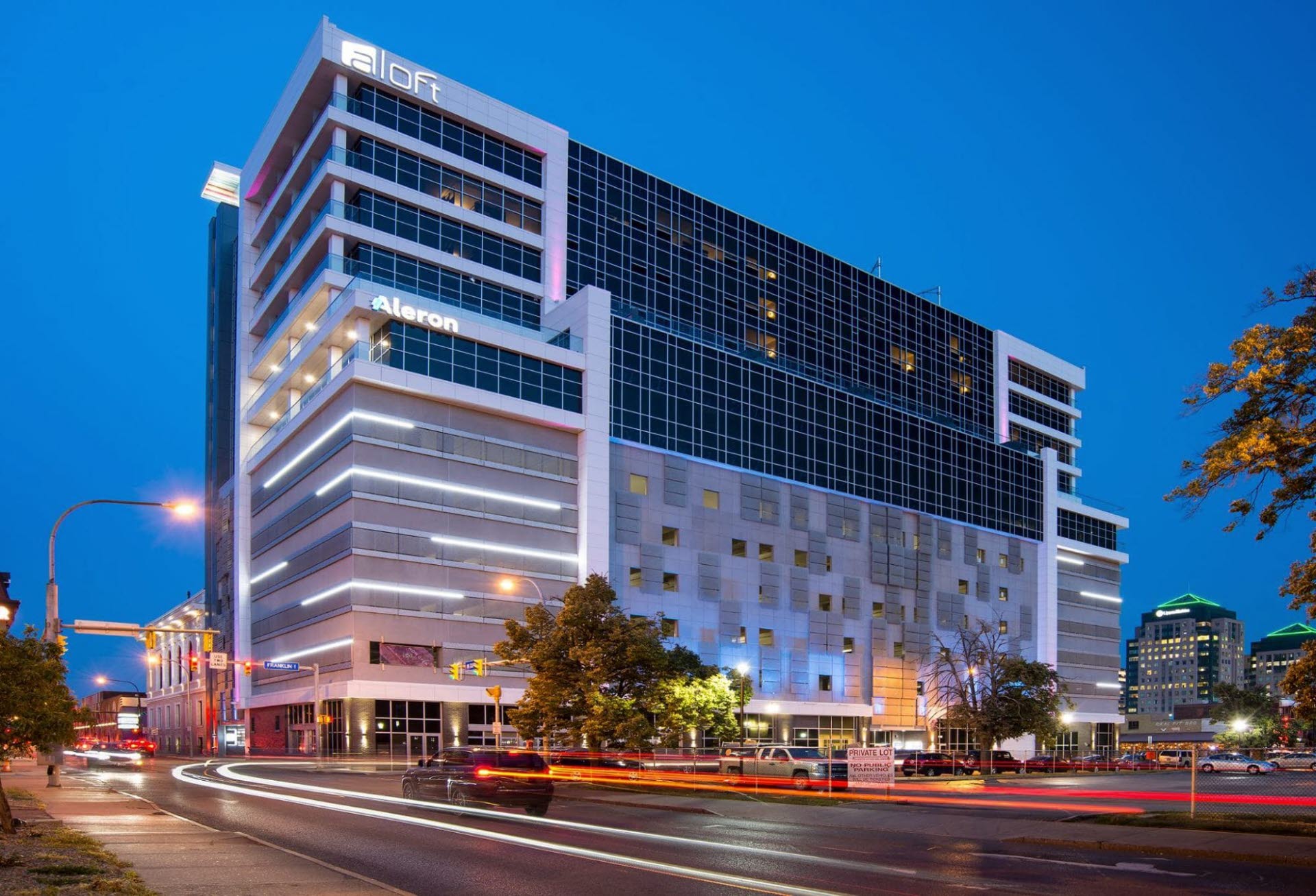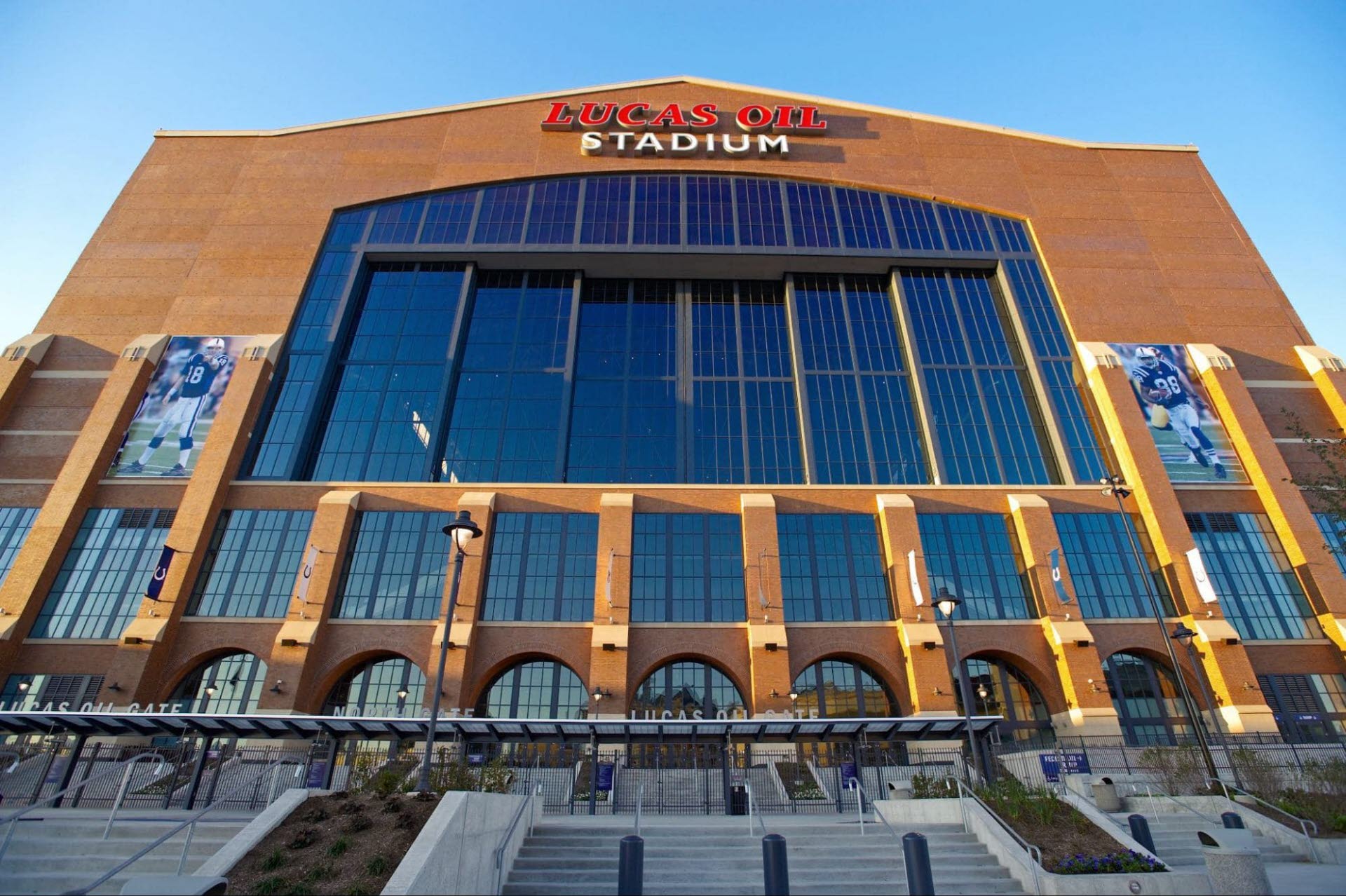5 Benefits of Precast Concrete Walls

Your building should represent your organization’s aesthetic and brand identity while achieving sustainability and energy goals. Precast concrete insulated cladding allows your company to go beyond your expectations with limitless design options, cost savings, and energy-efficient practices.
After reading this blog, you’ll have a better understanding of the different types of precast concrete walls, and how this building material can benefit your next construction project.
Structural & Architectural Precast Concrete Wall Types
Deciding what type of structural or architectural precast concrete wall to select will depend on your project’s budget and purpose. Walls are panelized and erected either horizontally or vertically and can be used in a variety of industries.
Solid Walls
Typically, solid walls are between 6 and 12 inches thick which helps them collect heat during the day and release it at night so you can better control the interior temperature of your building.
A solid wall does not have insulation and would require this as an additional step if you’re using these panels as an architectural structure. However, if you’re using these walls in a parking garage structure, it’s a cost-effective solution that still allows you to create something unique for your organization.
Like other types of precast concrete wall panels, solid walls can be used both internally and externally. This means that you can directly paint on the interior wall or include an additional wall system to complete the building process.
Insulated Walls
Precast concrete insulated cladding is a very energy-efficient building material. Three layers provide high thermal efficiency. Because of these layers, these panels are typically between 9 to 12 inches thick but can vary depending on your desired r-value.
Sometimes, you’ll hear these walls called “sandwich” walls because the insulation is between two layers of precast concrete. The walls stay extremely durable through wythes that hold all the layers together.
With two different concrete layers, you have the ability to choose two different concrete aggregates. This allows you to choose two distinct textures or colors to represent the interior and exterior of your structure. The Reading K-12 School used precast concrete insulated cladding to help minimize maintenance and maximize durability and thermal efficiency.
Load Bearing
As you work with a precaster, you’ll choose between load-bearing or non-load-bearing precast concrete wall panels. Load-bearing walls can support the weight of your structure and help eliminate the need for columns and beams within your building. Ultimately, this optimizes the interior space for your organization.
Unlike non-load-bearing walls, this type of precast concrete wall is a critical component of your structure and cannot be removed without being replaced. A variety of industries use load-bearing panels, including schools, student housing, and data centers.
Non Load Bearing
Also known as a “curtain wall”, non-load-bearing precast concrete walls are most commonly used as an enclosure system for a pre-existing structure. Since they do not hold lots of weight or support critical components of the building, they can be replaced and adjusted easily.

Shear
Shear and lite walls are seen mostly in structural parking garages rather than used as architectural precast concrete walls. This wall type transfers weight from the superstructure to the foundation.
Lite
Lite walls are very similar to shear walls, as they are used as internal support within parking structures. The difference is they have an opening in them to help bring in light. This is especially important for garages so cars have more visibility when they are driving through.
It can also be a great opportunity to add unique features to your parking garage. The Penn State Hershey Parking Garage designed the space to represent the rolling hills of Pennsylvania. These elements not only allowed more light to come in but helped be a safety feature for the garage.
How Precast Concrete Walls Benefit You
Precast concrete insulated cladding can be used in a variety of industries and customized to meet your organization’s needs. Below, you’ll learn about the 5 major benefits of precast concrete walls and how they can help you lower costs, build sustainably, and last longer.
1. More Energy-Efficient
Precast concrete wall panels are made with materials that can be found practically anywhere. This results in a more efficient process because there aren’t long transportation routes to bring everything together. Additionally, each precast plant only supplies to a certain radius around them so delivery and logistics delays are further reduced.
In a controlled environment, there is more precision and technique that reduces the amount of waste in each project. In 2018, the amount of construction waste generated was more than double the amount of municipal waste.
Once on the site, a majority of the precast structure is complete so assembly can begin immediately. Precast limits the number of additional trades needed to install and erect the building, offering minimal construction site congestion, debris, and risk. A quick and coherent process allows for maximum efficiency.
Not only is the precast concrete construction process more energy efficient compared to other building processes, but the building itself is a more sustainable option. The building envelope is an important asset to your project because it helps protect the interior from the exterior elements.
With a weaker building envelope, hot and cool air will easily travel in and out of your building. This could potentially mean you’re producing a lot of energy but not providing a comfortable temperature for the people within the building.
Because of the precast concrete wall’s density, it can better absorb and store a large amount of heat and then release it at night. You can also customize the colors of the wall to better reflect or absorb light based on your organization’s location.
2. Better Quality
A benefit of precast concrete insulated cladding is that they are constructed in a controlled environment with an assembly line process. Within the precaster plant, everyone working on your structure is specialized in what they do.
Compared to a typical construction site, with lots of moving parts and potential miscommunications, a precast plant has clear techniques and processes that help reduce the risk of errors and prolonged timelines.
In addition to the construction process, precast concrete walls are flexible so when your company needs to adjust or expand you can easily do that. To help combat the wall’s low tensile strength, you can choose to reinforce the precast insulated concrete walls with steel or welded wire mesh. This will help prolong your structure and defend against cracks.
3. Aesthetically Pleasing
When you use precast concrete to build a new building amongst a campus of older buildings, you want to make sure it seamlessly fits in. For example, Villanova’s campus needed a pedestrian walkway that embodied Villanova’s brand.
By combining various aggregates, cement, and pigments, we can create any color or texture for your panels. That way, your building doesn’t have to look like all the rest. Not only is precast a better choice for the environment but it’s also a more aesthetic building material.
Your design options for precast concrete walls are practically endless. Between different formliners and graphic concrete, you can put logos, text, and designs onto your structure to match your brand and aesthetics.

4. More Durable
On average, concrete has a psi level between 3,500 and 5,000. The higher the psi level, the more compressive strength the building material has. In turn, this means your structure will last longer with a higher psi level.
Precast concrete wall panels are very resilient to earthquakes, fire, and other severe weather. Depending on the location of your organization, it’s crucial to have a structure that can protect what you’re holding inside.
Precast concrete also has a lower water-cement ratio which helps it be a more durable building material. The water-cement ratio determines how much water is used for every 100 pounds of concrete, so if the ratio is .4, it means 40 pounds of water is used. The more water that is used, the thinner your concrete mix will be.
5. Lower Cost
Although the cost of your precast concrete building will depend on a host of factors, you’ll notice right off the bat that transportation and site logistics are significantly less when you choose precast concrete wall panels.
A majority of your budget will be set aside for designing and producing your structure. This means your budget is going to be allocated to things you can control, and things you can plan for. Ultimately, this helps you reduce the risk of going over budget because of unforeseen costs and delays.
For the most efficient production and shipping, precast concrete walls can be up to 45’ up to 13’. and load-bearing panels can be built to withstand multiple floors. Now that does not mean you need to have a panel that size. Flexibility for a larger or smaller panel is possible, but the best panelization can be achieved using these size guidelines.
As a result, you’re going to use fewer panels compared to other building materials. So, you’re saving money on materials and transportation.
When you select precast concrete insulated cladding, you can choose a simple, but still durable and efficient, aggregate mix as the interior wall and then paint over it your desired color. This not only can save you money but will also save you time. And time is money when it comes to your construction project.
Finally, because of the energy-efficient insulation materials, you’ll save money in the long run on HVAC systems and monthly utility bills. You will be able to better control the temperature inside the building.
In order to amplify all of the benefits of precast concrete walls, it’s essential that you connect with a precaster early on in the production process. That way they can help you decide what the best design, panelization, and wall type is to maximize your schedule and budget.
Ready to start your next project using precast concrete walls?
Let us help you start planning your timeline

